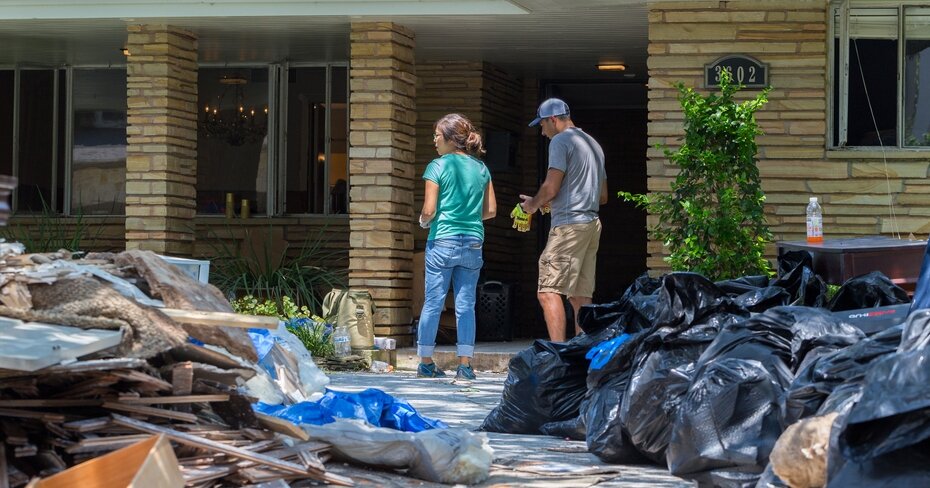What is an Act of God?
By: Arshi Hossain on November 21, 2023
The term "Act of God" traditionally refers to events or disasters that are beyond human control and foresight. These include natural calamities like earthquakes, floods, hurricanes, and other unforeseeable occurrences, such as lightning strikes or falling objects. You might have seen this ominous phrase in an insurance policy or two, particularly if you've ever rented a car in the U.S., or on your employer-sponsored health insurance policy. Typically known as "insurable perils' or 'unforeseen occurrences' in Canada, an Act of God simply refers to incidents where no human intervention of negligence is involved.
The Canadian perspective: Perils
Unlike in America, the term "Act of God" is typically not used within insurance policies in Canada. Instead, the industry relies on a nuanced set of terms and phrases such as:
Insurable perils: This term encompasses a range of events that are covered by basic insurance policies, such as loss or damage caused by hail, wind, and forest fires.
Unforeseen occurrences: Used to describe unexpected incidents such as tree falls, lightning strikes, or other accidents that are beyond human control.
Does Act of God exist in car insurance?
From weather-related incidents to unpredictable events, Canadian drivers must be well-versed in the implications of their coverage.
Specified perils coverage: Specified perils insurance offers protection for your vehicle against specifically named events, including but not limited to hail, windstorms, lightning damage, fire, floods, earthquake, and explosions. The details of specified perils coverage may differ among various insurance providers, which is why you should compare rates and coverage specifics when buying auto insurance. The level of coverage you choose, along with the corresponding rate, is dependent on the extent of protection you select.
Comprehensive car insurance: Comprehensive insurance coverage protects your vehicle from damages not caused by a collision. It covers a broad spectrum of damages, such as vandalism, extreme weather conditions, falling objects, and, in some cases, collisions with wildlife. Notably, comprehensive insurance does not extend coverage to damages or medical expenses arising from collisions or theft by a household member.
The financing factor
If you finance or lease your vehicle, comprehensive coverage is often a mandatory component of your financing or lease agreement. However, if you own your vehicle outright, you can choose to forego comprehensive coverage and potentially save money on your premium. You probably don’t need comprehensive coverage if your premium exceeds the assessed value of your vehicle, for example.
Specified perils vs. comprehensive auto insurance
Comprehensive insurance covers risks of vandalism or damage from falling objects, while specified perils coverage does not.
Beyond these specific claims, they have more similarities than they do differences.
Specified perils coverage is optional, allowing drivers to buy additional coverage for perils not typically included under a standard auto insurance policy. This might be the wiser option, especially if you own a newer vehicle. Not only does opting for a comprehensive policy keep your car safe against unforeseen damages or losses, it also gives you more peace of mind on the road.
Which perils are covered in standard home insurance policies?
Your basic home insurance policy may cover damages caused by the following types of unexpected events:
- Fire, lightning, and explosions
- Hail and windstorms
- Vandalism
- The impact from a vehicle or aircraft
- Civil disturbances or riots
- Falling objects
Your home is likely one of the most substantial investments you'll make throughout your life. The best way to ensure its protection is by choosing the appropriate home insurance policy.
Related: Fireworks safety in a wildfire country
Uninsured perils – what isn’t covered
An uninsurable peril is a risk that your insurance company refuses to cover by default. This means you’ll have to purchase additional coverage for these perils to adequately cover your needs.
- Earthquakes: Earthquake insurance is not typically included in standard home, condo, or tenant insurance policies. Homeowners in earthquake-prone areas, such as parts of British Columbia, may require more coverage to safeguard against structural damage. However, damage resulting from a fire or explosion caused by such earth movements is covered.
- Overland floods: Homes situated near rivers, lakes, or coastal areas face a higher risk of floods. Comprehensive coverage or standalone flood insurance can mitigate any financial losses in the event of a flood.
- Insects and rodents: Damage caused by insects and rodents is commonly excluded from coverage. Some policies may provide an exception for damage to building glass.
- Pollution: Home insurance policies typically do not cover damage caused by pollution.
Disaster assistance programs
Fire insurance is a mandate in Canada under the Insurance Act, meaning there are virtually no policies that won’t cover fire-related damages, including those caused by wildfires. There are notable exclusions in home insurance policies, particularly regarding certain weather-related events such as earthquakes, landslides, and coastal flooding. However, for property owners finding themselves in situations where private insurance falls short, there exists a safety net in the form of the Disaster Financial Assistance Arrangements (DFAA), a national government organization managed by each province and territory. When conventional property insurance does not extend coverage to certain events, the DFAA steps in to provide financial assistance.
However, you might not be eligible for specific forms of disaster assistance, depending on where you live and the insurance options that are available to you. If the province that you live in has specific insurance coverage for, say, earthquakes, and you chose to forego it, then you likely won't be eligible for disaster assistance in case an earthquake strikes. However, if you didn't have the option to purchase insurance coverage for earthquakes in the first place but your home is damaged by one, you may be able to receive government aid.
If you're concerned about extreme climate events and are uncertain about your coverage, talk to a broker to go over your options.
Separate policies for specific perils – named perils policy
If you're considering a strict essential-only coverage option, you might come across the ‘named perils’ policy type. This insurance approach offers protection against perils explicitly listed in the policy. The extent of coverage can vary, depending on the insurer's discretion, from a short list to a more robust set of named perils.
Named peril policies often come with lower premiums since they provide coverage for a specified set of risks in addition to what’s covered in a standard policy. This is a great option for those looking for budget-friendly coverage, as policyholders can tailor coverage to their specific needs by selecting only the perils deemed relevant to their situation.
Consider your risk tolerance and the specific risks prevalent in your area. If you seek comprehensive coverage and are willing to pay higher premiums, an ‘all perils’ policy might be a better fit.
All perils policy – comprehensive coverage options
Most comprehensive home insurance policies share common exclusions, although specifics may vary. While the specifics can vary among insurance providers, a typical ‘all perils’ policy covers the following:
- Perils explicitly named in the policy, similar to a named perils policy
- Unforeseen and accidental events that cause damage to your home and personal property
- Water damage caused by burst pipes, plumbing issues, or appliance leaks
- Falling objects
- Damage caused by the weight of ice, snow, or sleet accumulating on your property
- Damage caused by sudden and accidental impacts, such as a vehicle colliding with your home
- Explosions, whether from natural gas, or propane
- Theft or vandalism
Possible exclusions to your policy
While this coverage covers more risks, be aware of their exclusions to make sure your coverage aligns with your needs:
- Maintenance-related claims: Routine maintenance plays a vital role in preventing certain risks. As such, claims related to lack of maintenance, such as a deteriorating roof due to neglect, are generally not covered.
- War or terrorism: Highly destructive events like war or terrorism are typically excluded from coverage due to their unpredictable nature and impact.
- Large-scale natural disasters: Most comprehensive home insurance policies exclude coverage for major natural disasters and require the purchasing of additional coverage for earthquakes, overland floods, and tsunamis, particularly if your home is situated in a high-risk area. Coverage must be opted for as an additional feature by the policyholder.
- Any fraudulent activity: Claims resulting from fraudulent activities, whether by the policyholder or other involved parties, are excluded. Insurance is designed to protect against genuine risks, and fraudulent claims compromise the integrity of the coverage.
Every policy holder should check over their policy carefully to be certain of what's included and what's explicitly excluded to have clarity of where there are gaps in your coverage.
Climate change and its impact on insurance
Climate change is increasing the frequency and intensity of natural disasters and posing new challenges for the overall insurance industry. With more floods, wildfires, and storms on the horizon in Canada, homeowners should re-evaluate their risk assessments and coverage strategies.
In July 2023, Nova Scotia experienced a severe flooding event, resulting in damages exceeding $170 million, as reported by the Insurance Board of Canada (IBC).
According to the IBC, payouts for severe weather damage claims have doubled every five to 10 years since the 1980s. This highlights a concerning trend of increasing claims payouts, putting a further financial strain on insurance providers which trickles down to policyholders through higher premiums.
As this cycle continues, transformative changes are due within Canada's insurance industry. More payouts for severe weather damage claims pose challenges to the traditional risk assessment and pricing models employed by insurers.
Homeowners in high-risk areas susceptible to flooding should adopt climate adaptive measures like elevating the foundation above the baseline flood level, installing a sump pump, and routinely mantaining drainage systems and downspouts. It's also important to add the appropriate insurance endorsements to your insurance policy. Taking proactive measures will not only keep you personally safe but may also help you save money on insurance down the road.
Read next: Climate change is upending the home insurance industry. And it’s going to cost you
Save 32% on average on home insurance
Compare 50+ quotes from Canadian providers in 3 minutes.


